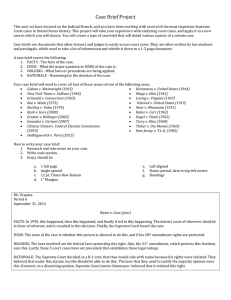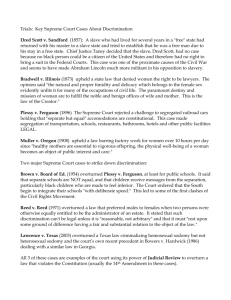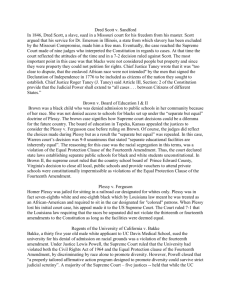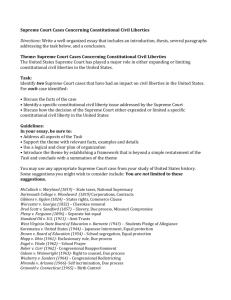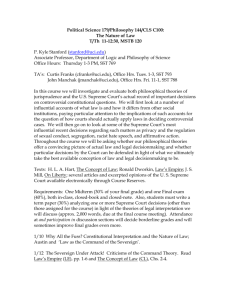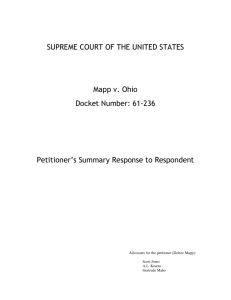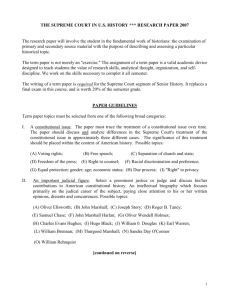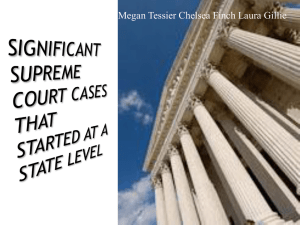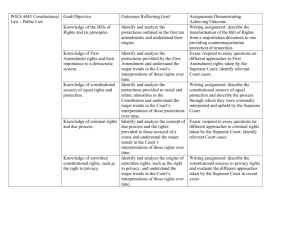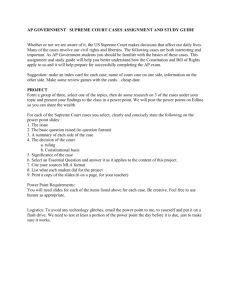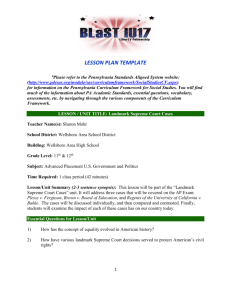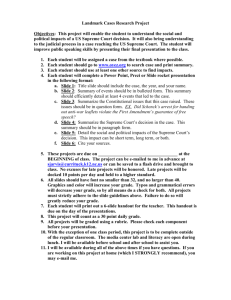Name:
advertisement
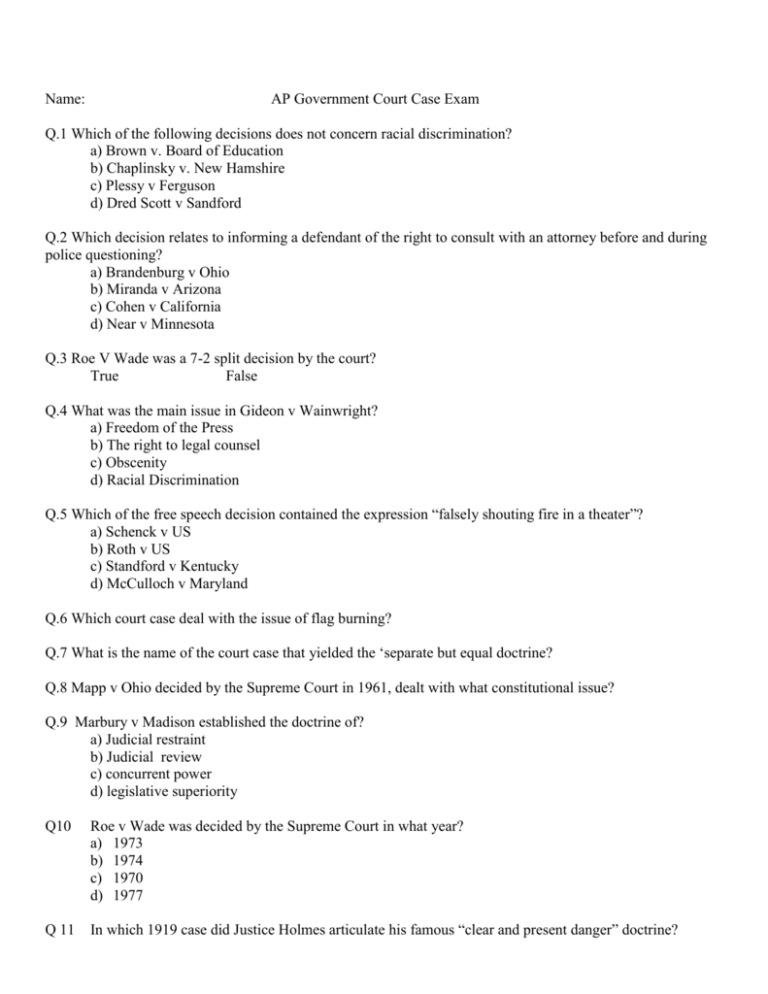
Name: AP Government Court Case Exam Q.1 Which of the following decisions does not concern racial discrimination? a) Brown v. Board of Education b) Chaplinsky v. New Hamshire c) Plessy v Ferguson d) Dred Scott v Sandford Q.2 Which decision relates to informing a defendant of the right to consult with an attorney before and during police questioning? a) Brandenburg v Ohio b) Miranda v Arizona c) Cohen v California d) Near v Minnesota Q.3 Roe V Wade was a 7-2 split decision by the court? True False Q.4 What was the main issue in Gideon v Wainwright? a) Freedom of the Press b) The right to legal counsel c) Obscenity d) Racial Discrimination Q.5 Which of the free speech decision contained the expression “falsely shouting fire in a theater”? a) Schenck v US b) Roth v US c) Standford v Kentucky d) McCulloch v Maryland Q.6 Which court case deal with the issue of flag burning? Q.7 What is the name of the court case that yielded the ‘separate but equal doctrine? Q.8 Mapp v Ohio decided by the Supreme Court in 1961, dealt with what constitutional issue? Q.9 Marbury v Madison established the doctrine of? a) Judicial restraint b) Judicial review c) concurrent power d) legislative superiority Q10 Roe v Wade was decided by the Supreme Court in what year? a) 1973 b) 1974 c) 1970 d) 1977 Q 11 In which 1919 case did Justice Holmes articulate his famous “clear and present danger” doctrine? Q 12 Which 1925 case hinted at the incorporation doctrine and set the precedent that federal courts could review speech issues? Q 13 In New York Times v Sullivan (1963), what did the Court state must be proved in order to prosecute for libel of a government official? a) Actual malice b) defamation c) sedition d) identification Q.14 Which case dealing with freedom of expression stated that students do not shed the constitutional rights while at school? a) Everson v Board of Education b) R.A.V v St Paul c) Tinker v. Des Moines d) Cohen v California Q.15 Brandenburg v Ohio (1969) provided further protection for dangerous speech by adding what requirement to the clear and present danger test? a) Imminence b) sedition c) severity d) lucidity Q.16 Who was the Chief Justice in 1999? Q.17 What did Lochner v New York deal with? Q. 18 which case did the Supreme Court decide that it was constitutional to allow separate but equal for whites and blacks? Q.19 What did the Supreme Court find unconstitutional in the case, Clinton v New York? Q. 20 Which of the following Supreme Court cases do not argue over the rights of the first Amendment? a) McCulloch v Maryland b) New York Times v US c) Engel v Vitale d) Schenk v US Q. 21 In Debs v United States Oliver Wendell Holmes used the precedence set in which other case to arrive at this decision. (The two plaintives ’ belonged to the same party) Q.22 The issue raised by the case of Regents of the University of California v. Bakke (1977) was that of: a) Gun control b) Reverse Discrimination c) Reverse incorporations d) Rights of homosexuals e) Nationalization of Public Education Q. 23 the plantiff presents the argument that his thirteenth and fourteenth amendment rights have been violated because he was arrested for refusing to leave a “whites only” railroad car. You rule in a 7-1 decision that his rights have not been violated and that “separate but equal” facilities are constitutional. This case is known as: a) Dred Scott v. Sanford b) Brown v. BOE Topeka c) Plessy v. Ferguson d) Griswold v. Connecticut Q. 24 The case is made that the separate schools for black students do not provide the equal opportunities that white school provide and there fore the Equal Protection clause of the fourteenth amendment is violated. You and court agree, and rule 9-0 that segregation is unconstitutional. a) Heart of Atlanta Motel v. U.S. b) Brown v. BOE Topeka c) NAACP v. Alabama d) Power v. Alabama Q. 25 A white medical school applicant is arguing that his fourteenth amendment rights have been violated under the Equal Protection Clause because he was denied admission, even when his test scores were higher than those who had been accepted, who were of a different race. You rule in a 5-4 decision in favor of the student. This case is known as: a) Regents of The University Of California v. Bakke b) Marbury v. Madison c) Wygant v. Jackson Board of Education d) Grutter v. Bollinger Q. 26 the plantiff says the court should send a “writ of mandamus” to the secretary of state so that he will be forced to deliver his commission that will allow for him to become a Supreme Court justice. This case is known as: a) Hurtado v. California b) Gitlow v. New York c) Dred Scott v. Sanford d) Marbury v. Madison Q. 27 an African-American slave is making the case that since he lived in a free state for a time, he should be a citizen of the United States. His plea is rejected/ and you rule in favor of the property owner. This case is known as: a) Dred Scott v. Sanford b) Roe v. Wade c) Hamden v. Rumsfeld d) Plessy v. Ferguson Q. 28 this plaintiff argues that her fourteenth Amendment rights, specifically the Equal protection clause, have been violated because when applying to undergraduate school, more points are automatically given to racial minorities, instead of basing it on the individuals. This case is known as: a) Gratz v. Bollinger b) Bakke v. Regents of university of California-Davis c) Grutter v. Bollinger d) Powell v. Alabama Q.29 You rule that because of the United States Commerce Clause, found in the Constitution, this owner is not able to refuse service to the African-Americans. This case is a) Smith v Allwright b) Heart of Atlanta Motel V United States c) Sweatt v Painter d) NAACP v Alabama Q.30 You hear that an Amish man wants to take his child out of public school, and home school him, because of religious reasons However, state laws outlaw homeschooling, and so it would be unlawful for this man to take his child out of public schooling. You rule in favor of this Amish man. The case is known as: a) Cohen v California b) Lemon v Kurtzman c) Wisconsin v Yoder d) Lee v Weisman Q. 31 You hear that a state law banning contraceptives is violating the plaintiffs right to privacy. The court agrees and rules against the state. This case is know as a) Miranda v Arizona b) Lawrence v Texas c) Griswold v Connect d) Bowers v Hardwick Q. 32 & 33 Herring V US, Mapp V Ohio and ________________ all deal with the issue of __________. Q.34 Which court case ruled that a persons religious beliefs do not excuse them from complying with the law? Q.35 Miller v Johnson ruled that gerrymandering was unconstitutional. Which prior court case did the Supreme Court use to base it decision on? Q.36 On what grounds did Chief Justice Rehnquist order that the recount of the Florida Presidential election of 2000. Q.37 What was the key constitutional issue in the Cherokee Nation v Georgia? Q. 38 Which court case deal with congress power to incorporate a bank? Q.39 In Buckley v Valeo what was the decision of the court? Q. 40 Based on what case must a High School Administrator provide notification and or hold a hearing before suspending a student?
